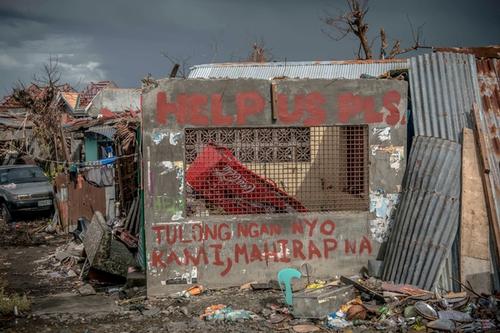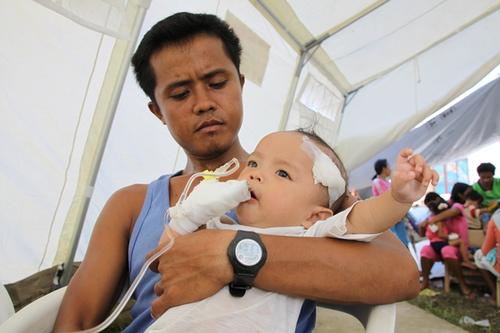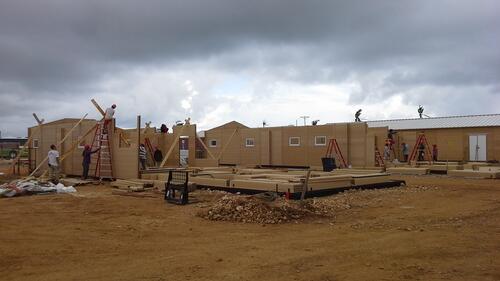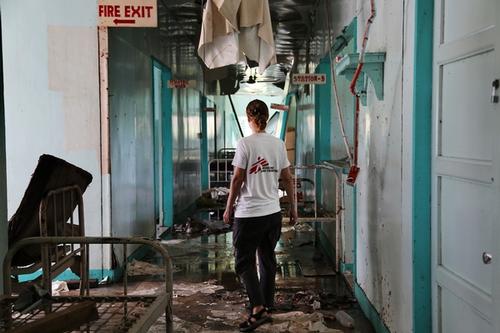Ten days after Typhoon Haiyan struck the region, ports and airports are still congested with cargos of relief aid. Meanwhile communities in many remote areas continue to fend for themselves.
“Help us please”. These are the words painted in large red letters by a survivor in Tanauan town on what remains of his house. Tanauan is a small town of 50,000 inhabitants located about 20 kilometres south of Tacloban on the island of Leyte.
Around 95 per cent of the town was destroyed. Many people are living on the streets, begging for water, food and shelter. While the streets of Tacloban are almost completely cleared, in Tanauan, bodies are still floating in the rivers. A wave a dozen metres high swept away everything in its path. The pile of debris still blocks most roads. Only the main road has finally been cleared, allowing access for vehicles delivering aid.
Less aid in further rural areas
"The further you go into the rural areas, the less aid you find, with some areas receiving no aid at all. Some people have no other option than to sleep outside under the heavy rains,” said Caroline Seguin, Médecins Sans Frontières (MSF) emergency coordinator. “Today, the main obstacle to the delivery of aid is logistics. Small airports on the island of Leyte are not designed to handle large airfreight. They do not have adequate infrastructure to unload and store the huge amounts of cargo arriving."
“The fact is that aid is not yet reaching the most remote areas," asserts Laurent Sury, head of MSF’s emergency programmes. "To overcome this bottleneck, more support should be given to the airport, including setting up additional rotations of aircrafts to accelerate the dispatching of supply to the affected areas. MSF is focused on reaching the most isolated areas and we’re now seeing more and more patients."
Tetanus main concern
In Tanauan, 70 per cent of the 200 daily consultations are for patients with infected wounds.
"The risk of contracting tetanus is one of our main concerns. We must be able to vaccinate the injured quickly but also need fridges and electricity supply to store the vaccines," said Seguin.
The deputy mayor – himself a doctor – has been providing basic medical care in the town hall, despite it missing half its roof. Initially, MSF supplied the municipality with medicines and medical equipment, and is now quickly installing a fully equipped health centre to restore primary health care services in Tanauan.
Local solidarity
So far, the bulk of relief operations has been made possible by local solidarity, with survivors deploying any means at their disposal. "In Palo, the governor himself lent us his car, including the petrol. In Tacloban, a team of speleologists (cavers) helped us to clear the parking lot where we’ll install our inflatable hospital," says Seguin.
While the frequency of typhoons in this area has made the population particularly resilient to disasters, the extent of the destruction caused by the storm surge devastated miles of coastline. There is an urgent need to ensure that the aid does not get stuck in ports or airports, and finally reaches the regions currently beyond its reach.
MSF is currently expanding medical humanitarian assistance in five of the most affected areas, spanning three islands, in the Philippines. MSF is now working in the Guiuan area on Samar Island, in the areas around Tacloban, Ormoc and Burauen on Leyte Island and the area around Roxas and Estancia on Panay Island. A fully equipped inflatable hospital will be installed in the coming days in Tacloban city to re-establish secondary healthcare services and serve as a referral centre for peripherals health posts.






